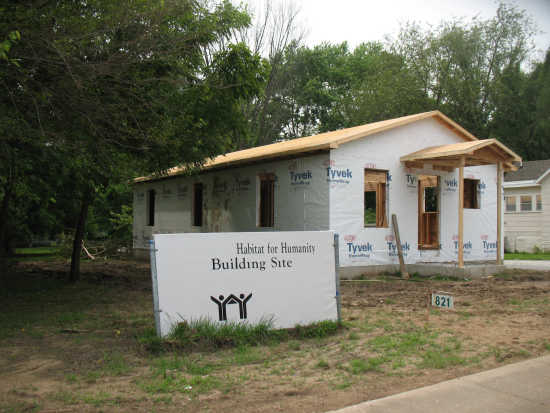Local Habitat chapter builds Energy Star home

In Nevada, a great deal of loving care, hours of dedication, sweat and teamwork goes into building the Habitat for Humanity homes; so it's only appropriate that one of the staples of life -- potatoes -- are also one of the staples that provides a level of funding that has enabled the chapter to build nearly one home per year since its first project in 1996.
Thanks to generous donations from many sources, plus income from the hundreds of potatoes local folks purchase for lunch each month, September through May, the Nevada Area Habitat for Humanity's 10th home is now under construction.
"We've learned from every house we've built, said Darryl Wright, president of the charity's local chapter, as he led a short tour around the construction site on Saturday.
A work day had been planned for that sunny morning, but since necessary materials weren't expected to arrive by then, the work day had been cancelled. As it turned out, materials had arrived after all, but scheduling changes are just part of the process, Wright indicated.
"That's one thing about construction. It never quite goes the way you planned it," Wright said.
This project, for example, has been coming together better than anyone had imagined. Erwin Construction came to the Habitat group and said they weren't too busy, so they'd like to frame the home and had completed much of the task by Saturday.
The home, between 800 and 900 square feet, is meant to meet the needs of a local woman and her daughter.
"We build to meet their current needs. This will be more than enough for the two of them. If she ever decided to get married again, they'll have a decision to make," Wright said.
There will be two bedrooms, one bathroom a living room and a kitchen. Outside, there'll be a small carport.
"We found with our first few houses that we weren't giving them any kind of a place to store lawn equipment, stuff like that," which the carport will help to provide, even though, strictly speaking, that's beyond what Habitat generally does.
The last Habitat house didn't include a carport, but there was a garage already on the property.
The home also has the the local chapter and Tom Taylor (also a licensed plumber, who'll help install the home's waterworks) exploring new territory -- it's an Energy Star home, which means it will meet strict standards of energy efficiency and will incorporate extra insulation and energy -efficient appliances.
Wright said that doing the project this way gives the homeowner a more practical, less expensive place to live.
"You have to have a job, meet the financial guidelines, and you have to be living in sub-standard housing," Wright said, noting that, by extension, living in "sub-standard housing" often means poorly insulated homes that have high utility bill associated with them.
The savings in utility cost, he said, can be dramatic.
Whirlpool offers Energy Star appliances to the charity at a deep discount; and insulated windows will be provided, Storm doors from Larson Storm Doors also will be put in the home.
"We feel strongly that this will be a great benefit to the homeowner," Wright said.
People who get a chance to own a home through Habitat for Humanity don't get a free ride. Before Habitat hands over the key, the homeowner must log hundreds of hours in sweat equity, building their habitat and the houses of others.
There's a down payment and a mortgage.
The low-income family pays for the home over time.
